A couple of years ago the novelist Richard Powers suggested that the salvation of humanity depended on our development of tree consciousness. ‘We are here by the grace of trees and forests,’ he said. ‘They make our atmosphere, clean our water, and sustain the cycles of life that permit us. Just begin to see them […] Notice all the million complex beautiful behaviours and forms that have always slipped right past you. Simply see, and the rest will begin to follow.’
Unsurprisingly, visual artists have always appreciated trees, firstly for their symbolic uses and subsequently for their aesthetic appeal. Think Bruegel, Hobbema, Hokusai and Constable, Vincent Van Gogh, Paula Modersohn-Becker, Piet Mondrian and Emily Carr. The list of tree-loving painters is endless. But in a time of changing climates, disrupted habitats and shrinking biodiversity what can modern and contemporary practitioners teach us about our biological and environmental relationship to some of the oldest life forms on the planet?
In London we will shortly have an opportunity of finding out when ‘Among the Trees’ opens at the Hayward Gallery in the spring. According to the press release, ‘Among the Trees’ will bring together artworks that explore our multifaceted connections with trees and forests and invite us to consider how trees have helped to shape human civilisation. The exhibition will encompass a range of artistic approaches from the past 50 years and celebrate the tree’s enduring resonance as a source of inspiration for some of the most significant artists of our time.
In the second half of last year visitors to the Fondation Cartier pour l’art contemporain in Paris were rewarded with what I suspect was a rather more ambitious treatment of the same theme. ‘Nous les Arbres’ (‘We the Trees’) focused on the work of an international group of artists, botanists, architects, philosophers and shamans – many from South America and its indigenous forest communities – who have developed an intimate connection with trees.
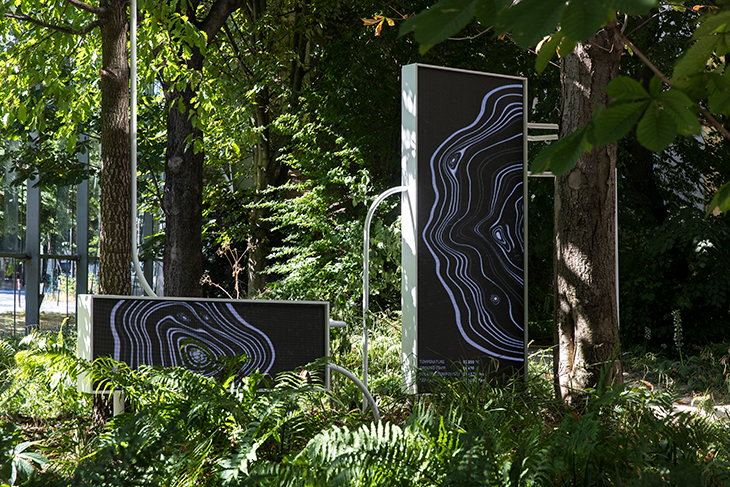
Installation view of Symbiosia (2019) by Thijs Biersteker and Stefano Mancuso in ‘Nous les Arbres’ at the Fondation Cartier, Paris. Photo: Thibault Voisin
The Fondation Cartier has a history of staging refreshingly unexpected shows and anyone who has visited boulevard Raspail will know that the wild-looking garden, designed by Lothar Baumgarten in 1994, is an integral part of the site. Baumgarten’s Theatrum Botanicum (‘Theatre of Plants’) places the emphasis firmly on trees and they enter into a close conversation with Jean Nouvel’s diaphanous building. Baumgarten spent months at a time in the 1970s living in a remote Venezuelan rainforest with the Yanomami people, immersing himself in their way of life. His experiences formed the basis of numerous exhibitions and his ideas almost certainly inflected the current project alongside those of the anthropologist Bruce Albert and his co-curators Hervé Chandès and Isabelle Gaudefroy.
‘Nous les Arbres’ began by exploring the poetic and spiritual interaction between humans and trees after which trees became the subject of study and representation. In the garden outside sat new commissions by Agnès Varda, Tony Oursler, and Thijs Biersteker in partnership with the botanist Stefano Mancuso, founder of the International Laboratory of Plant Neurobiology.
Albert, Chandès and Gaudefroy imagined the exhibition as a walk through a forest guided by three narrative threads: scientific knowledge, visual and philosophical contemplation, and the devastation wrought by global deforestation. Although these threads become hopelessly entangled, the material on display remained constantly engaging.
The main ground-floor gallery was transformed into an urbanised jungle, at the centre of which was a living tree. The effect was created by pairing Luiz Zerbini’s table-herbarium and hyper-real paintings of tropical vegetation and modernist architecture with drawings of plants and animals by Joseca, Esteban Klassen, Marcos Ortiz and other artists from the Yanomami, Nivacle and Guaraní peoples of Venezuela, Brazil and Paraguay.
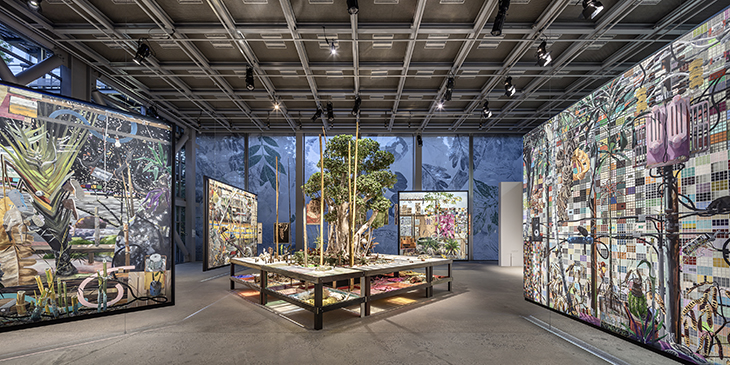
Installation view of Luiz Zerbini’s table herbarium in ‘Nous les Arbres’ at the Fondation Cartier, Paris. Photo: Luc Boegly
Forest dwellers for hundreds if not thousands of years, the Yanomami, Nivacle and Guaraní have a deep-rooted understanding of plants and trees, using fruit, leaves and bark for food, medicine and ritual. The sometimes delicate, sometimes ecstatic drawings by the artists in the show captured the multitude of visible and invisible beings that share their jungle homes and point to a codependency, which is under serious threat from legal and illegal logging and widespread land clearance for cattle rearing, soybean cultivation and mining.
On the far side of the building, Fabrice Hyber, Afonso Tostes, and Raymond Depardon and Claudine Nougaret offered up personal interpretations of our ages-old links with timber and trees. In their enchanting film Mon Arbre (‘My Tree’), Depardon and Nougaret travel across France to give ‘a voice to the men and women who are surrounded by [trees], cherish them, observe them, defend them, care for them, admire them’, and even those ‘who are a little tired of living with them’.
The exhibition continued downstairs with around 200 pieces by twenty creatives, including Salim Karami, Johanna Calle, Sebastián Mejía, artist-botanist Francis Hallé and architects Diller Scofidio + Renfro, which concentrated on the visual allure and architectural complexity of trees while arguing against their containment and destruction.
Concluding the show was a cinema-scale installation by writer-director Paz Encina. Aromas que trae el viento (‘Aromas that the wind brings’; 2019) plunged visitors into the heart of the Gran Chaco forest in the River Plate basin. Fascinated by the power of dreams and recollection, Encina combines recent footage, shot mostly in Asunción, with archival film from her childhood on to which she has superimposed the bark and leaves of local trees.
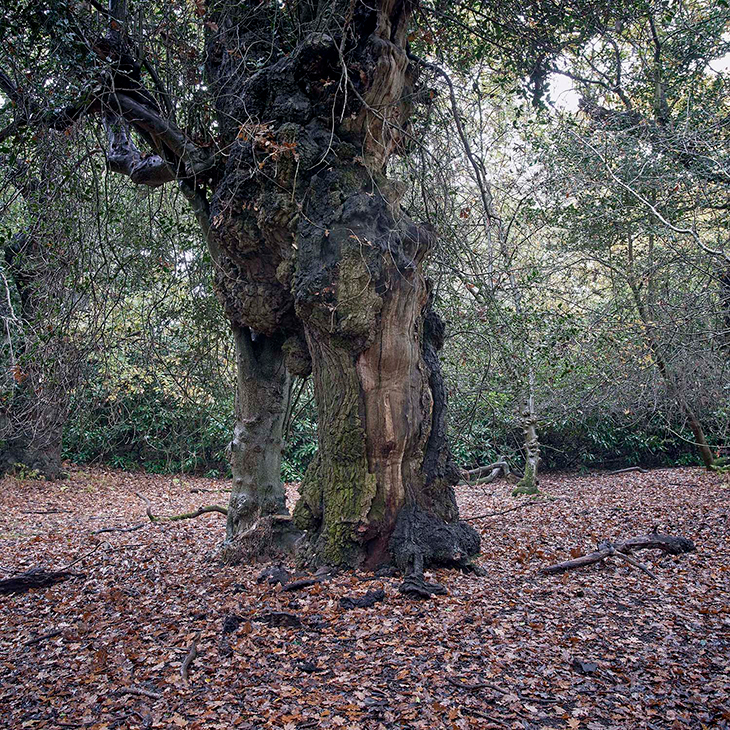
The Thicks – yesterday’s tomorrow (detail; 2018), Jeremy Young. Photo courtesy the artist; © the artist
Curators of thematic shows are obliged to be selective in their choices, but I was particularly disappointed that ‘Nous les Arbres’ could make no space for The Thicks – yesterday’s tomorrow (2018). Jeremy Young’s astonishing photographic tribute to the ancient oaks and hollies at Staverton Park in Suffolk highlights the remarkable longevity of trees and goes a long way towards explaining why trees exert such a powerful grip on the human imagination.
In his foreword to the book on The Thicks, nature writer Mark Cocker says that he tried ‘to imagine a kind of speeded-up cinematic portrait of all the billions of individual organisms […] that have lived and flourished and then passed among these trees. Think of all that volatile life, here, both then, and now, growing, singing, moving, full of colour and passion. Such a meditation makes you realise that Staverton is a kind of Garden of Eden.’
The Garden of Eden’s tree of the knowledge of good and evil, the huluppu tree in the Epic of Gilgamesh, Yggdrasill in Norse cosmology – legends and mythologies are full of trees that comprehend and articulate the meaning of existence. Venerable individuals like the oaks and hollies at Staverton Park express it moment by moment as loss and recovery, memory and time.
‘Nous les Arbres’ closed at the Fondation Cartier pour l’art contemporain in Paris on 5 January. ‘Among the Trees’ opens at the Hayward Gallery in London on 4 March.
Unlimited access from just $16 every 3 months
Subscribe to get unlimited and exclusive access to the top art stories, interviews and exhibition reviews.

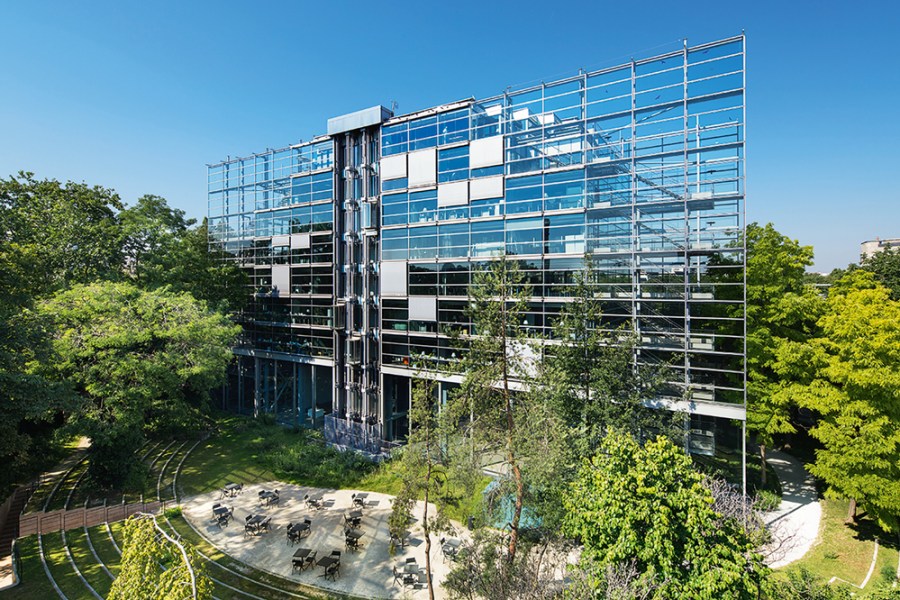
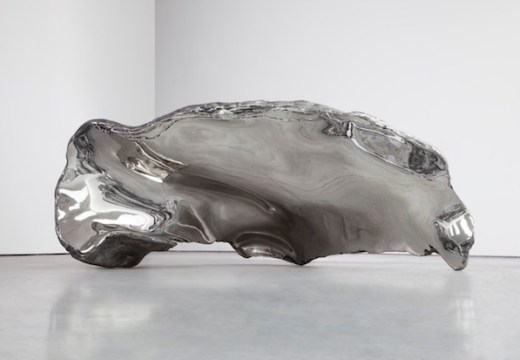
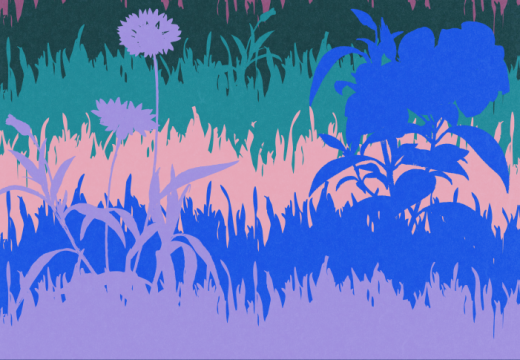
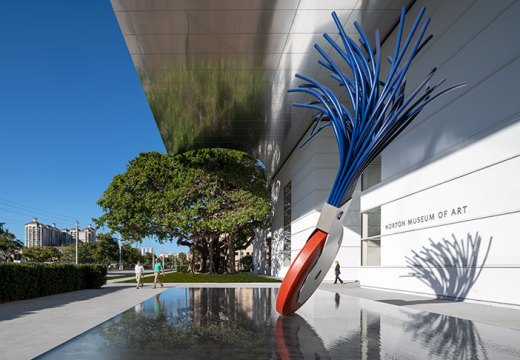









![Masterpiece [Re]discovery 2022. Photo: Ben Fisher Photography, courtesy of Masterpiece London](http://www.apollo-magazine.com/wp-content/uploads/2022/07/MPL2022_4263.jpg)
Is the Stirling Prize suffering from a case of tunnel vision?